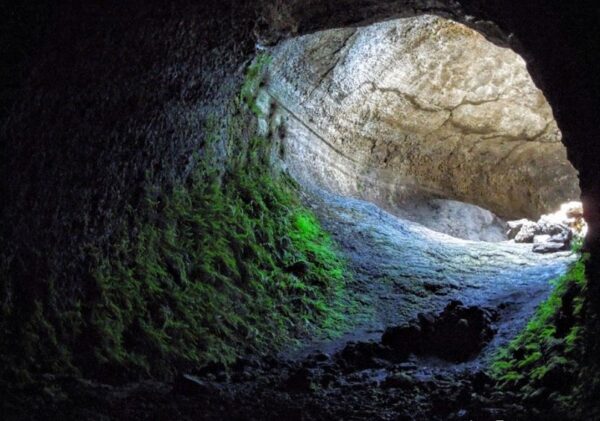There was a period, in the mid-17th century, when seeing Etna erupting had become so normal that the volcano with the flame on top appeared everywhere. It was in the frescoes of the churches, in the paintings of noble families’ houses, in the heraldic symbols … . That fire that lit up the night was now everyday life, during the longest eruption in the volcano’s modern history: that of 1614-1624. An entire generation of people from Catania grew up, in that period, with lava in their eyes and perhaps with the conviction that that eruptive event would last forever. Today, in memory of that show, we find many geological testimonies scattered across the north side of Etna. Including the Sciara del Follone.
The longest eruption
The great eruption that characterized the first part of the 17th century began in July 1614. And like many others before it, it included earthquake swarms, localized fractures and then a large movement that had split the ground on the north flank for kilometres, from 2550 meters down. Eruptive vents had formed (the Deserti Craters) from which rich lava flows had come out, consisting of unusually fluid material which in some points created real sculptures of “rope lava”.
That eruption would forever change not only the physical aspect of the volcano but also man’s relationship with it. Between pauses and resumptions, in fact, the eruption of July 1614 went on for a good ten years, ending only in 1624. Over a billion cubic meters of lava covered the frightening surface of 21 square km. There were also numerous engorgements, with rivers of fire disappearing under the solid crusts and emerging further downstream.
The miracle is that in all this time, and despite so many phenomena all together, no inhabited center was ever destroyed by this eruption. Once the sources upstream were extinguished, and the flows stopped, what remained of that terrible spectacle were real natural monuments.
The Sciara del Follone and the Corpses Hill
 PHOTO BY ivan testa etnanatura it
PHOTO BY ivan testa etnanatura it
The Sciara del Follone old lava flow is what remains today of this grandiose eruption. These are kilometers of black rocks that intertwine and overlap, forming canals and caves and exceptional sculptures. Above and around it, the vegetation makes it green and beautiful, especially in spring, even if it is difficult to walk or climb these expanses of rock.
The attraction of the Sciara del Follone is certainly the Monte dei Morti (Corpses Hill). It is a roped lava pile located above 1900 meters, where the twisted and massed rock has taken on the appearance of dead human bodies. In short, it seems to see a pile of corpses blackened by time (large photo above by Etnanatura.it). Certainly impressive and fascinating at the same time, it is a favourite destination for many hikers and also for courageous tourists who are not afraid of long and tiring walks.
Caves and glaciers
There are many grottos and small cavities dug out by the lava in the immense Sciara del Follone. It is always necessary to go together with expert hiking guides and/or speleologists because the caves you find here must be explored in complete safety.
The Grotta del Diavolo, Grotta dei Lamponi and Grotta del Gelo certainly stand out, but the Grotta di Aci and the Grotta del Lago are also worth a visit. Grotta del Diavolo (Devil’s Cave) is the most twisted and among the deepest ones. It divides in some pits that go down for meters, inside which the lava has formed terrifying images (hence the name). Grotta del Gelo (Frost Cave), at an altitude of 2030 meters, is the “southernmost glacier in Europe” because where fire once flowed, today snow accumulates for months, forming columns of ice that rarely melts. Until recently considered the only glacier on Etna, today it has been flanked by two other similar caves.
Grotta dei Lamponi (Grotto of Raspberries) is the longest lava flow cave on Etna, made up of several tunnels, some of which are over 200 meters long. The collapse of some parts of the domes has produced openings that guarantee air but also light and amazing colours inside. The Grotto of Aci is a rather small cavity, but characterized by a network of internal mini tunnels. The beautiful Grotto of Lago is located in the Dammusi locality. It is made up of very high tunnels, with shapes that recall a church’s nave and numerous underground channels that have not been fully explored. Inside, the ice melts in summer forming a large pool of fresh water, once used by shepherds for their sheep.
How to visit the places of the 1614-1624 eruption
The closest towns to the sites of the 1614-1624 eruption are Maletto, Randazzo, Solicchiata and Linguaglossa. In particular from Randazzo and Linguaglossa you can start with the guides to discover the Sciara del Follone. It is a route suitable for off-road vehicles, up to a certain level, and then only on foot and with several hours of walking. Do not go if you are not trained or if you have any physical problem that prevents long and tiring walks. It is necessary to bring the necessary slings with you, so to explore, if possible, the lava caves.